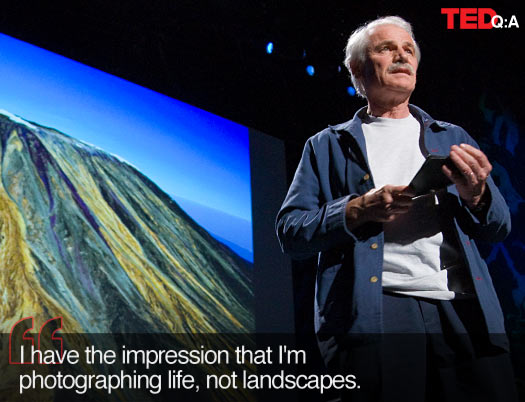
Today, photographer Yann Arthus-Bertrand launched his movie Home, an environmentally conscious tour of our planet through panoramic vistas that focuses on human impact — our mistakes and possibilities for improvement. Yann took some time out of this busy day to answer a few questions for the TEDBlog by email, going beyond his recent TEDTalk to give us insight on his attempts to document and save our home and humanity.
How was your experience at TED? Did you enjoy giving a TEDTalk?
Wonderful experience, especially the audience and the people I met during the sessions. It would be great if we did something similar to TED in France.
As you can see and hear, even with a lot of rehearsals, I’m not a great speaker. I guess that’s why I take pictures and made a movie.
Have you seen your TEDTalk online? What did you think of it?
Not yet. The last few days have been hectic.
Today is Home’s world premiere. It’s happening in more than 100 countries, in 33 languages and on 65 TV channels from Nepal to Burkina Faso, from Russia to Argentina, and of course in the United States.
Is there anything you would have liked to say in your TEDTalk, but didn’t have time to?
Don’t tempt me. I never lose an opportunity to speak about my obsession: humankind and the environment.
Why the aerial photography? How did you come to decide that this was the perspective for you? Not scared of heights, we take it?
I learned to be a hot-air balloon pilot to take tourists over the Masaï Mara Reserve, in order to earn some money and finance the work I was doing with my wife Anne. We were studying the life of a family of lions for more than two years. Taking pictures was a way to capture information we could not put in words.
What are the mechanics behind getting your aerial shots? Your website says that helicopters are best, but what do use when one isn’t available? Do you use harnesses for safety?
I have the impression that I’m photographing life, not landscapes. For me an aerial picture is no different than a close-up portrait. It’s a question of framing and angle. Helicopters are great for that. But I’ve also used planes. Of course, I always have a harness.
Any close calls when leaning out of an aircraft to capture an amazing shot? Would you like to share the story?
After Hurricane Katrina, over New Orleans, my helicopter crashed and the pilot and I were only saved because we fell on the roof of a flooded house that absorbed the shock. When the helicopter was spiraling downward out of control, I didn’t expect to survive at all.
You’re a photographer, but also an environmentalist in many ways. Was there a particular experience or time in your life, maybe in your childhood, that sparked your commitment to building awareness of our environment and your fascination with nature?
My fondness for nature goes back to childhood, but it was as an adult that I became an advocate. Like a lot of people, it was in 1992, during the Earth Summit in Rio, that for the first time I heard expressions like climate change, biodiversity, sustainable development. I felt like an urgency to act — or to put it in another way, to use my work for this cause.
READ MORE: Yann talks about more about Home and “6 billion Others,” moving from photographs to film and projects still to come.Can you speak a little more on your movie, Home? Tell us how the project started, why you believe this concept can make a difference and the impact you expect it to have on release.
I discovered Al Gore’s documentary and I decided to help promote it in France. We showed An Inconvenient Truth to the French deputies and senators, because as a whole they didn’t think climate change was an important matter. The legislative power didn’t reflect the opinion of the French people. Polls were showing that climate change was important to them and politicians were lagging behind. This film really helped get the message through. Cinema — moving pictures — is a very powerful medium so I decided to use it and follow in Al Gore’s footsteps.
With regard to your other recent project, “6 billion Others“, can you explain what inspired the move from huge shots of nature to up close and personal interviews? If there’s a connection for you, what is it?
I wanted to learn more about and from the people I was flying over. We must share this planet, but we don’t know anything about our neighbors.”6 billion Others“, like Home, is an invitation to act.
When putting together the project, were there any testimonials that really stood out to you? In other words, do you have any favorites?
Not really. What is special is that you feel during the interview, that the person is saying things she never said before to anyone.
How was the move from still photographs to film? Was that totally seamless for you?
I discovered moving pictures through a series of documentaries from French public television. I didn’t know anything and discovered that, aside from working with a bigger team, it’s the same logic and I got a grip on it.
Any more projects on the horizon?
Maybe a Home 2. At the end of the year, for the Copenhagen meeting, we’ll be interviewing people in different countries — scientists, but also ordinary people — on their perception of climate change.
Comments (3)
Pingback: Flavorwire » Photo Gallery: Stunning Aerial Photographs from Around the World